CENVAT & Thyssenkrupp decision - Time for CBEC to clarify
NOVEMBER 11, 2014
By Ankit Shah
BY pronouncing its decision in the case of Thyssenkrupp Industries (I) Pvt. Ltd vs Commissioner of Central Excise, Pune 2014-TIOL-1825-CESTAT-MUM, the CESTAT, Mumbai and has tried to put to rest an ongoing controversy surrounding the computation of the quantum of reversal under Rule 6(3A) of CENVAT Credit Rules, 2004.
The Bench has inter alia held - Rule 6(3A) of CCR, 2004 - 'P' denotes total CENVAT Credit taken on input services during FY and not total of CENVAT Credit taken on common input services - If formula leads to an anomalous situation, remedy lies in amending provisions of statute and judiciary is helpless.
However, the said decision has now opened a new plethora of arguments that could increase the quantum of litigation in this regard.
A small background of Rule 6 of CCR is provided herein before analyzing the decision of CESTAT.
A manufacturer of final products or provider of output services is not allowed to take CENVAT credit on inputs and input services exclusively used in the manufacture of exempted goods and provision of exempted output services [Rule 6(1)].
Assessee, engaged in taxable as well as exempt activities, has to maintain separate records in respect of 'receipt, consumption and inventory of inputs and 'receipt and use of input services' with reference to each such activity i.e. separately for taxable and exempt operations. [Rule 6 (2)]
However, the assessee, who is not opting for either of the Rules mentioned supra, is supposed to reverse the CENVAT credit either to the extent of 6% of value of exempted goods/services or to the extent of amount determined in accordance with Rule 6(3A). [Rule 6(3)]
Relevant extract of Rule 6(3A) is reproduced for the ready reference.
"Rule 6(3A) (c)… (iii) the amount attributable to input services used in or in relation to manufacture of exempted goods and their clearance up to the place of removal or provision of exempted services = (M/N) multiplied by P, where M denotes total value of exempted services provided plus the total value of exempted goods manufactured and removed during the financial year, N denotes total value of output and exempted services provided, and total value of dutiable and exempted goods manufactured and removed, during the financial year, and P denotes total CENVAT credit taken on input services during the financial year;"
It is germane to note that vide Explanation II to the said sub-rule, the availment of credit on services used exclusively for providing exempted services is prohibited.
Analysing the input services used by assessee/taxpayer, Inputs/Input Services can broadly be classified into the following types:
a. Inputs/Input Services used exclusively for provision of taxable services
b. Inputs/Input Services used exclusively for the provision of exempted services.
c. Inputs/Input Services used for provision of both taxable as well as exempted services. (commonly referred to as common services)
Through invocation of Explanation II credit of the services used exclusively for provision of exempted services is barred, the result of which is that a manufacturer or service provider is only left with Inputs/Input Services in situations described in "a"&"c" mentioned above.
Invoking Explanation II mentioned above, bar is on availment of Inputs/Input Services used exclusively for the provision of exempted services. The inference of which could entail that assessee/taxpayer should get full credit of 'a' i.e. services used exclusively for provision of taxable services as the entire services have been used for provision of taxable services. Further, common services are the only services that have been used for provision of taxable and exempted services and so utilization of full credit would be a loss to the revenue. Accordingly, the provisions of proportionate reversal can be adopted in respect of such inputs/services used commonly for provision of both exempted and taxable services.
This would in turn lead to a situation wherein neither the assessee/taxpayer nor the revenue is put to loss with regards to credit availment.
However, the Tribunal seems to have formed a different view by interpreting the words literally and not trying to look into the beneficial interpretation. The Tribunal held that the rule signifies total CENVAT and not credit of common services thereby leaving no scope for interpretation in the current matter.
The question now arises is whether Rule of beneficial interpretation rather than literal be invoked for the purpose of decision making.
In this regard the following decisions need to be taken note of while seeking an answer to the above questions -
In Union of India v. Azadi Bachao Andolan, 2003-TIOL-13-SC-IT the Hon'ble Supreme Court held that if two views are possible with respect to any provisions under a taxing statute, the view which is in favour of the assessee should be accepted.
Further, the Apex Court in Hindustan Lever Ltd. v. Municipal Corporation of Greater Bombay, 1995 (3) Scale, page 24, and in the case of Birla Cement Works v. CBDT, 2002-TIOL-846-SC-IT-LB has established that if the words used in a taxing statute are reasonably open to two interpretations, the interpretation which goes in favour of the assessee should be accepted.
Furthermore, in CIT v. Podar Cement (P.) Ltd. 2002-TIOL-445-SC-IT-LB it was held that where there are two possible interpretations of a particular section which is akin to a charging section, the interpretation which is favourable to the assessee should be preferred while construing that particular provision. In CIT v. Vegetable Products Ltd 2002-TIOL-574-SC-IT-LB it has been held that if the Court finds that the language of taxing provision is ambiguous or capable of more meaning than one, then the Court has to adopt the interpretation which favours the assessee.
Tribunal in this regard,in the case of Thyssennkrupp(supra),stated "It is a well settled position in law that while interpreting statutes, no words can be added or removed/deleted from the statute. As held by Rowlatt J., "in a taxing statute one has to look merely at what is clearly said. There is no room for any intendment. Nothing is to be read in, nothing is to be implied. One can only look fairly at the language used." If, we apply this principle to the formula prescribed in sub-rule (3A), there is no scope for interpreting the term "P" otherwise. If the formula leads to an anomalous situation, the remedy lies in amending the provisions of the statute and the judiciary is helpless."
Accordingly, it held that the wordings of CCR, 2004 are clear and do not contain any ambiguity.
But is this provision really without any ambiguity?
The Explanation II states that credit of services used exclusively for provision of exempted services will not be permitted. A logical inference of this would be that services which are used exclusively for provision of taxable services should be allowed.
This supposition would automatically lead one to infer that proportionate reversal should be only of services used commonly for provision of taxable and exempted services.
It seems that the Tribunal has opened the gates of litigation & only a clarification from the Central Board of Excise & Customs in favour of the assessee should provide some relief as a soothing balm. But, the CBEC rarely is known for such generosity!
(The author is an Associate with Khaitan & Co)















